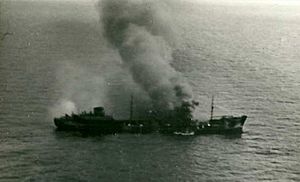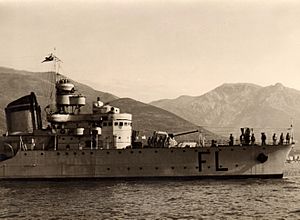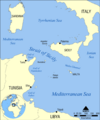Battle of the Duisburg Convoy facts for kids
Quick facts for kids Battle of the Duisburg Convoy |
|||||||
|---|---|---|---|---|---|---|---|
| Part of the Battle of the Mediterranean of the Second World War | |||||||
 Italian tanker Minatitlán on fire and sinking in the morning of 9 November 1941 |
|||||||
|
|||||||
| Belligerents | |||||||
| Commanders and leaders | |||||||
| Strength | |||||||
| 2 light cruisers 2 destroyers |
2 heavy cruisers 10 destroyers 7 merchant ships |
||||||
| Casualties and losses | |||||||
| 1 destroyer damaged | 1 destroyer sunk 2 destroyers damaged 7 merchant ships sunk |
||||||
The Battle of the Duisburg Convoy, also known as the Battle of the BETA Convoy, was a naval battle during World War II. It happened on the night of 8/9 November 1941. The battle was fought between an Italian convoy, its escort ships, and four British ships.
The Italian convoy was called "BETA" and was carrying important supplies. These supplies were for the Italian Army, civilian settlers, and the German Afrika Korps in Italian Libya.
A British naval group, called Force K, was based at Malta. They completely destroyed the convoy. All seven merchant ships were sunk. The Italian destroyer Fulmine was also sunk. The British ships suffered no losses and almost no damage. The next day, another Italian destroyer, Libeccio, was sunk. This happened while it was rescuing survivors. It was torpedoed by the British submarine HMS Upholder.
After this battle, the Germans were very critical of the Italian Navy. They pushed for German officers to be placed in Italian naval headquarters and on their ships. The Italians tried to avoid British attacks by sending smaller groups of ships. But this did not work. The British were able to read Italian naval codes. The next Italian convoy had to turn back to port.
Contents
Why the Battle Happened
War in the Mediterranean
Italy joined World War II on 10 June 1940. This meant that Italian forces were now positioned along the main British sea route. This route went through the Mediterranean Sea and the Suez Canal to the Indian Ocean. The Italian Navy was much larger than before. It had many more battleships, cruisers, and submarines.
Britain had naval bases at Gibraltar and Alexandria in Egypt. They also used the island of Malta as a key base. In September 1940, Italy invaded Egypt from Italian Libya. This led to fighting in the Western Desert Campaign.
Supplying the Fight
The Axis powers (Germany and Italy) needed to supply their forces in North Africa. They sent convoys across the Mediterranean from Italy to Libya. Tripoli was the main port in Libya. Other smaller ports were also used.
The usual route for Italian supply ships was long. They sailed west around Sicily. Then they hugged the coast from Tunisia east to Tripoli. This was to avoid British planes, ships, and submarines from Malta. Once in Africa, supplies had to travel long distances by road.
German Forces Arrive
In early 1941, Britain had a big victory in Egypt. But then, Germany sent new forces to Libya. This was called Unternehmen Sonnenblume (Operation Sunflower). These German troops, known as the Deutsches Afrika Korps (DAK), had better tanks and equipment. They quickly pushed the British back to the Egyptian border. They also surrounded the port of Tobruk. The front line stayed near the Egyptian border until November 1941.
Malta's Role
From June to October 1941, British forces based at Malta caused huge losses to Axis shipping. They sank about 220,000 tons of Axis supplies. Most of these losses were ships carrying goods to Africa. British planes and ships from Malta were responsible for most of these sinkings.
In October 1941, the British brought back a group of surface warships to Malta. This group was called Force K. Italian air patrols spotted these ships on 21 October. Because of this, Italy cancelled many sailings to Tripoli. This left only the smaller port of Benghazi for supplies.
Getting Ready for Battle
The Duisburg (BETA) Convoy
The "Duisburg" or "BETA" convoy was a very important mission. It included two German ships, SS Duisburg and SS San Marco. It also had three Italian ships: MV Maria, SS Sagitta, and MV Rina Corrado. These ships carried 389 vehicles and 34,473 tons of ammunition, fuel, and troops. Two tankers, Conte di Misurata and Minatitlan, carried 17,281 tons of fuel.
A strong escort was planned for the convoy. This was to protect it from Force K, the British ships at Malta.
The convoy had two groups of escorts:
- Close Escort (Captain Ugo Bisciani): This group included six destroyers: Maestrale, Grecale, Libeccio, Fulmine, Euro, and Alfredo Oriani.
- Distant Escort (Vice Admiral Bruno Brivonesi): This group had two heavy cruisers, Trieste and Italian cruiser Trento. It also had four destroyers: Granatiere, Fuciliere, Bersagliere, and Alpino.
The convoy took a new route, east of Malta. This was because Axis forces now controlled airfields in Libya. The convoy moved at 9 knots (about 10 mph). The distant escort had to zig-zag at 16 knots (about 18 mph). The Italians thought the British could not attack at night. They did not realize British ships had radar.
Force K's Plan
Force K was led by Captain William Gladstone Agnew. It had two light cruisers, HMS Aurora (Agnew's flagship) and Penelope. Each had six 6-inch guns. They also had two destroyers, HMS Lance and Lively. These destroyers joined Force K at Malta.
All British ships had radar. The cruisers also had new, powerful searchlights. This made them ready to fight at night.
The Battle Begins
7 November
The Duisburg (BETA) Convoy left Naples on 7 November. The British knew about the convoy because they had broken Italian naval codes. Force K sailed the next day. A British reconnaissance plane was sent to "find" the convoy. This was to make it seem like a normal discovery.
8/9 November
Force K sailed northeast of Malta at 28 knots (about 32 mph). Aurora led the ships in a single line. Around midnight, they found the main convoy. It was about 135 nautical miles (155 miles) east of Syracuse. There was a slight moonlight to the east. The British ships positioned themselves so the moon silhouetted the convoy.
Agnew had orders to attack the closest escort ships first. Then, he would fire on the merchant ships. The British ships slowed to 20 knots (about 23 mph). The gun crews were told to fire steadily and accurately. As they got closer, radar detected more ships. These were the distant escort.
Force K sent an attack signal at 12:47 a.m. The Italian cruiser Trieste received it. But jamming from Lively stopped the warning from reaching the convoy. Only ships 9.2 nautical miles (10.6 miles) away knew about the attack.
The British ships opened fire at about 12:58 a.m. They used radar to aim from about 5,200 yards (2.5 miles) away. The destroyer Grecale was hit by the first shots from Aurora. Lance and Aurora's smaller guns attacked a merchant ship. Penelope fired at Maestrale, the leader of the close escort. Lively started shelling the merchant ships three minutes later.
At first, the Italians thought they were under air attack. The radio mast of Maestrale was hit. The destroyer Fulmine tried to attack. But it was quickly badly damaged by British gunfire. Its captain, Mario Milano, lost an arm but stayed in command until the ship sank. Grecale was hit and stopped. It was later towed back to port by Oriani.
The destroyer Euro was not damaged. It came within 2,000 meters (2,187 yards) of the British ships. But it mistook them for its own cruisers, Trieste and Trento. This was helped by the British ships not firing on Euro. Maestrale had been telling Italian ships to gather on the far side of the convoy. This caused Euro's captain to cancel an order to launch torpedoes. Moments later, the British ships opened fire. But Euro was no longer in a good position to attack. Six British shells hit Euro. But they passed through without exploding because the range was so short. About twenty crew members were killed.
The distant escort was on the right side of the convoy. It was sailing twice as fast and zig-zagging. They also thought the convoy was under air attack. At 1:13 a.m., Admiral Brivonesi signaled to Italian naval headquarters that torpedo planes were attacking. He then sailed towards where the British ships were first seen, not their current position.
When lookouts on Trieste saw shells flying and ships burning, the distant escort was about 5,000 yards (2.8 miles) away. As the escort got closer, the British ships moved beyond the glare of the burning ships. This made them much harder to see. Trento fired star shells to light up the area. Then both Trieste and Trento opened fire at the British ships from 8,700 yards (4.9 miles).
From 1:10 to 1:25 a.m., the British attacked the Axis merchant ships with shells and torpedoes. The merchant ships did not try to avoid the attacks much. The close escort on the east side of the convoy moved away. Maestrale and Euro gathered and then attacked again. The Italian shots had no effect. The British then drove them off.
The distant escort saw the British ships again. They fired 207 large 8-inch rounds. Some shells landed close to the British ships. The fires and explosions on the merchant ships hid the British ships. Brivonesi ordered the distant escort to turn north at 24 knots (about 28 mph) to intercept them. But they made no further contact. Some shells landed close to British ships as they finished off the convoy. Only Lively's funnel got minor splinter damage. By 1:40 a.m., the firing had stopped.
9 November
All of the Axis merchant ships had sunk or were on fire and sinking. At 2:05 a.m., the British ships headed at high speed towards Malta. The Italian covering force chased them without success. Force K reached Malta by 1:00 p.m. that afternoon. They had sunk about 39,800 tons of Axis shipping.
The destroyer Libeccio was torpedoed by the submarine HMS Upholder. This happened while Libeccio was rescuing some of the 704 survivors from the BETA Convoy. Libeccio was taken in tow by Euro. But it sank after its structure collapsed inside. The Italian cruisers were also looking for survivors. They managed to avoid torpedoes.
After the Battle
The Battle of the Duisburg Convoy was a major victory for the British. It showed how effective Force K was at Malta. It also highlighted the challenges the Italian Navy faced. The loss of so many supply ships was a big blow to the Axis forces in North Africa.
Images for kids



